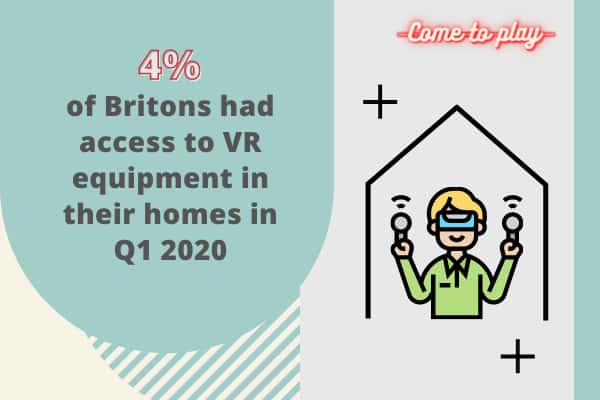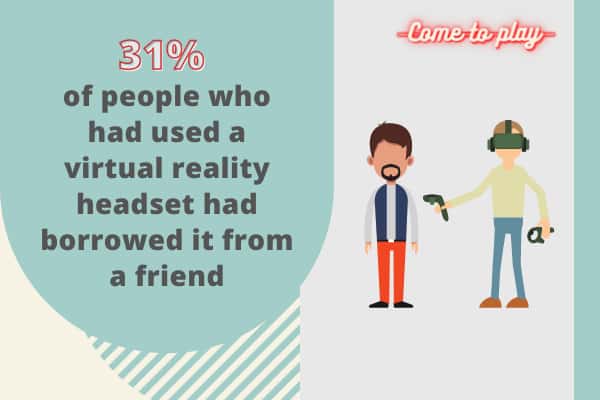Here we will look at things like what the VR market share is, which industries are pushing its development, and which are the latest trends in virtual reality in gaming.
Let’s dive in head-first.
Up-to-the-Minute Virtual Reality in Gaming Statistics for 2024
- 4% of Britons had access to VR equipment in their homes in Q1 2020.
- In 2017, there were 101 established AR and VR companies in the UK.
- There were 244 AR/VR companies in London alone in 2017.
- By 2024, the global VR/AR market is expected to be worth $72.8 billion.
- Over the next decade, VR and AR could add £62 billion to the UK economy.
- By 2023, the UK’s VR entertainment market is on track to be worth £294 million.
- 47% of the content developed for immersive technologies in 2020 was for social media.
- The global VR gaming market is forecasted to grow by up to $92.31 billion by 2027.
- Gaming accounts for 53% of total VR spending in the UK.
- 35% of British and American internet users aged 25-34 have used VR technology.
General VR Statistics and Demographics

1. 4% of Britons had access to VR equipment in their homes in Q1 2020.
(Statista)
The most recent international statistics reveal that fewer than one in 20 consumers in the UK have VR technology at their disposal in their households.
While this puts Great Britain ahead of Germany, Norway, Sweden, and Denmark with their 3% and Finland with 2%, it lags behind the USA in this regard, where 6% of respondents to an online survey said that they owned such a device.
2. In early 2019, 14.9% of Brits reported owning a virtual reality headset computing device.
(Statista)
The latest data on virtual reality demographics in the UK indicate that millennials are the most likely generation to own a VR set at 21.7%.
Somewhat expectedly, baby boomers were at the opposite end of the spectrum with just 8.5%. Gen-Zers reported 15.3% headset ownership, while members of Generation X—10.7%.
3. In 2017, there were 101 established AR and VR companies in the UK.
(Statista)
Reports from mid-2017 show that at the time, in terms of maturity, there were 174 virtual reality companies in the UK considered to be startups.
There were also 123 scaleups, as well as 65 micro-companies.
4. As of July 2017, 308 companies in the UK were dedicated to VR content creation.
(Statista)
While the greatest number of British companies in the VR business as of July 18, 2017, created content for this market, there were an additional 110 firms that dealt with VR technology and 45 that provided related services.
5. There were 244 AR/VR companies in London alone in 2017.
(Statista)
For many companies involved in augmented and virtual reality in the UK, venture capital is a popular and effective form of funding. As of the summer of 2017, such businesses based in London shared $645.74 million US in VC funding.
This is immense compared to those in second-ranked Dundee, which got just $16.8 million. Firms in Farnborough were third with $8.69 million, Bristol-based ones were fourth with $2.24 million, whereas those in Edinburgh came in fifth with $1.7 million.
VR Market Statistics

6. By 2024, the global VR/AR market is expected to be worth $72.8 billion.
(Techinformed)
In 2020, the global spend on VR and AR was just over $12 billion. Techinformed virtual reality market projections suggest that by 2024, as the pandemic tapers off, the augmented and virtual reality market size is expected to expand at a compound annual growth rate (CAGR) of 54% over the five-year period.
7. Over the next decade, VR and AR could add £62 billion to the UK economy.
(PwC)
The virtual reality market forecast in a recent report released by PwC suggests that by 2030, VR and AR could boost the UK economy by 2.4% in terms of GDP. Augmented reality is expected to contribute £44.4 billion, while virtual reality £18.1 billion.
The two segments are also likely to create 400,663 jobs by then.
Globally, VR/AR might add £1.4 trillion to the world’s GDP in the next decade, adding to the industry’s estimated worth of £41.9 billion in 2019.
8. The expected CAGR of the UK’s AR/VR market from 2019 to 2025 is 33.3%.
(Research and Marketers) (Allied Market Research)
A virtual reality market forecast by Research and Marketers indicates that over a seven-year period, this industry is set to expand by a third in the UK.
An Allied Market Research report, in turn, expects the international AR and VR market to grow at a CAGR of 63.3% from 2018 to 2025.
9. By 2023, the UK’s VR entertainment market is on track to be worth £294 million.
(Immerse UK)
The virtual reality data in The Immersive Economy in the UK report forecasts that the country’s VR entertainment market will be the fastest-growing of any other entertainment and media sector, nearly tripling in value from £118 million in 2018 within five years.
10. 47% of the content developed for immersive technologies in 2020 was for social media.
(Perkins Coie)
Social media-specific content was what augmented and virtual reality companies worldwide focused on the most in 2020, reporting an increase of 16% year over year in its production.
Below it on the list were video games with 40%, followed by live streaming with 32%, film and entertainment with 31%, and advertising and music, both with 28%. News and visual stories were produced by 27% of firms, while 14% made other types of content for virtual reality uses.
VR Gaming Statistics

11. The global VR gaming market is forecasted to grow by up to $92.31 billion by 2027.
(Grand View Research)
The demand for a more realistic experience through virtual reality headsets that simulate 3D environments is expected to fuel this market’s expansion. Grand View Research projects that the total virtual reality games industry will grow at a CAGR of 30.2% in 2020-2027 from $11.56 billion US in 2019.
12. In 2024, AR/VR consumer use cases will account for $17.6 billion in spending.
(TelecomTv)
The combined spend on consumer use cases for VR (VR gaming, VR video/feature viewing, and AR gaming) in 2024 is expected to exceed $17 billion.
However, commercial use cases like training and industrial maintenance ($4.1 billion each) and retail showcasing ($2.7 billion) are expected to receive the largest investments that year.
13. Gaming accounts for 53% of total VR spending in the UK.
(Immerse UK)
The main driver of Great Britain’s VR market growth is the gaming sector.
The latest data from a report compiled by Immerse UK and Digital Catapult show that gaming accounted for over half of all virtual reality revenue in 2018.
14. In the UK, esports is the fastest-growing segment of the VR gaming industry.
(Immerse UK)
According to the Immersive Economy in the UK report, in 2019, esports or events where video games are played competitively for an audience (in an arena or via live stream) is the fastest expanding segment of the British VR gaming market.
15. By 2022, esports revenue in Britain is predicted to reach £48 million.
(Immerse UK)
As competitive video games become more widely embraced by popular culture, VR predictions show that the demand for esports will increase accordingly. Esports revenue is mainly generated from the sale of individual games and events.
16. 12% of console gamers in the UK plan to buy VR headsets in 2021.
(YouGov)
Most VR gamers use consoles, according to a YouGov survey. In Britain, 7% of gamers who preferred to play on consoles reported owning or having access to a virtual reality headset.
However, in the year from January 2021, this number is expected to increase by 5%.
17. 9% of Britons who use a PC for gaming will likely get a virtual reality headset.
(YouGov)
The use of virtual reality in the gaming industry is exploding. However, only 5% of PC gamers in the UK use virtual reality units, indicating that they’re still on the fence about VR gaming.
Namely, fewer than one in ten PC gamers said that they’d likely purchase virtual reality goggles within the year.
18. In Britain, 24% of gamers see no practical application for VR.
(YouGov)
On the whole, gamers are more cynical about the usefulness of VR than the general UK population, 22% of which agrees that it has no everyday application.
In comparison, close to one-quarter of British gamers are pessimistic about the practicality of VR technology.
UK vs US VR Statistics

19. 35% of British and American internet users aged 25-34 have used VR technology.
(GlobalWebIndex)
According to research on VR user demographics in the UK and USA, over a third of people aged 16-34 have had a virtual reality experience. In addition, 26% of 35-44-year-olds, 12% of 45-54-year-olds, and 6% of 55-64-year-olds had used this type of tech by 2018.
20. At 30%, males are more likely to have tried out a virtual reality headset.
(GlobalWebIndex)
Overall, people are getting more and more comfortable with VR. For example, the data from a GWI survey on VR demographics in Great Britain and the US show that almost one-third of males had tried a virtual reality headset as of 2018.
On the other hand, only 16% of the users of virtual reality were female.
21. 31% of people who had used a virtual reality headset had borrowed it from a friend.
(GlobalWebIndex)
In the UK and the USA combined, 43% of those who had used a virtual reality headset in the month prior to being polled said that they owned the gear, while 24% had availed themselves of one at an event or a store.
In addition, the majority of VR users, or 42%, had experience with a virtual reality headset that was in the mid-range market, whether borrowed or owned, whereas as many as one-third boasted of having used a high-end device.
22. For users, gaming is where VR has the most potential.
(GlobalWebIndex)
As many as 64% of users of virtual reality in the UK and US surveyed in 2018 said that this technology had the most exciting potential in gaming, whereas 52% agreed that it had the ability to enhance film and TV viewing the most.
Further, 42% believed that it’d make watching sports more immersive, while 41% were enthusiastic about its applications in the classroom. Finally, 38% of the respondents felt that it’d augment the social media experience.
Companies, in turn, looked forward the most to creating ads for such platforms, but the adoption rates at the time of the poll were deemed too low to justify investing in VR marketing.
Doing a 360
After you’ve scrolled down to here you probably know by now that VR is the future in gaming.
Even though most people are thrilled primarily about the integration of virtual reality in gaming, the possibilities for the application of this type of tech are potentially endless.
You may also like: Oculus Quest statistics and Virtual Sports Betting Sites

